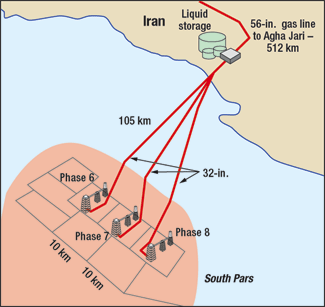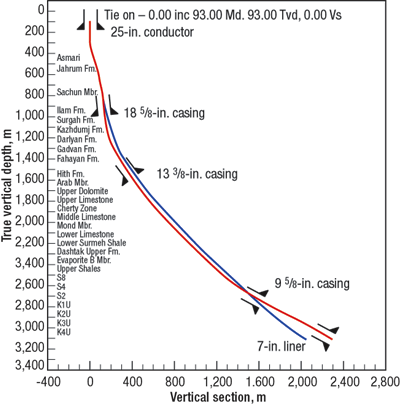Drilling Technology
Drilling development wells in less time with lower cost
Determining the criteria for choosing between a motor/ VGS combination and RSS when drilling extended-reach wells.
Jon Symons, Toolbox Drilling Solutions, Ltd, Aberdeen
North Sea and GOM operators were early leaders in the adoption of Rotary Steerable Systems (RSS) when the tools entered the market in the late nineties. Increasing rig costs and the need to reach ever more complex targets were the driving forces behind this adoption. However, with announced deepwater rig dayrates already topping $500,000 in 2006, it appears that downhole reliability is playing an increasing role in the drive to reducing drilling costs.
There is no doubt that when a RSS works well, it drills a smooth hole. Similarly, there is little doubt that when the well path needs complex geometry, it may not be possible to make the necessary turns without an RSS. But, what happens when that same RSS tool has to be pulled because the complex electronic package has failed, when it can not build angle at the required rate, or if something mechanical packs-in or falls off?
MOTOR/ VGS COMBINATION
North Sea companies like BOL, Conoco Phillips, CNR, Devon, Encana, Gaz de France, NAM, Nexen, Shell, Statoil, Talisman, Wintershall, etc., appear to have found the answer and regularly run a motor/ Variable Gauge Stabilizer (VGS) combination when the well profile is less complex. Historically, three out of every four correction slides with an RSS are for inclination. Adding a VGS to a positive displacement motor (PDM) allows the driller to correct for inclination changes without having to orient and slide. The motor/ VGS becomes, in effect, a low-cost rotary steerable system.
Faced with rising rig rates, operators are again looking at the motor/ VGS, because it is less expensive to run than an RSS. Motor prices have halved over the past six years and, although VGS prices have remained firm, it is fair to say that a motor/ VGS today costs no more than a motor run did at the end of the last century.
Motors have continued to develop, have become more powerful and have gained in downhole reliability. It is interesting to note that while Baker Hughes Inteq (BHI) promotes the virtues of its RSS, it has also continued to develop its PDM fleet. Their newest addition is the X-treme motor, i.e., a special performance motor for high-profile, performance applications that is reported to handle higher temperatures, greater torque, WOB and more aggressive drilling fluids. BHI has recognized that the motor still has a fundamental part to play in the directional market. They, too, see the operator becoming more discerning of where and how they run downhole packages.
Similarly, National Oilwell Varco (NOV), showed its new two-speed, downhole-switchable motor at last year’s OTC. All the big motor providers have announced significant motor footage drilled and motor revenue increases over the past 12 months, over and above the global drilling activity increase.
A similar evolution has occurred with the VGS. Hydraulic activated tools have replaced the original weight-set actuation tools. With continuing advances in motor technology, a larger VGS gauge change was required. The new tools offer a choice of blade positions, while reliably indicating blade gauge from any depth. If a PDM could drill for 600 hours or more, then a VGS had to reliably operate and signal gauge change to the surface over that same time. The new VGS tools had to be user friendly, so the directional man could run them without a specialist engineer.
CASE HISTORY
The requirement to improve both performance and reliability persuaded Statoil to look at the motor/ VGS when planning the drilling program for their South PARS field, offshore Iran. An extension of Qatar’s giant North field, South PARS covers an area of 500 sq mi with gas located 3,000 m below the seabed, Fig. 1.
 |
Fig. 1. Statoil batch-set the 12¼-in. sections on their South Pars field development.1
|
|
Required to batch drill all their 12-1/4-in. sections, Statoil wanted tools that were reliable. When BHI was awarded the directional contract, it decided to run its new motor. But, due to the irregular formations and the need to keep sliding to a minimum, the company required a VGS tool to provide the required build, hold and drop with the same assembly. The company also wanted a tool that would signal reliably from depth, no matter the length of time in-hole. The tool also had to be simple to use, as rig space was at a premium. Above all, the VGS had to be reliable. Because Statoil wanted to batch-set their 12-1/4-in. sections, both motors and VGS tools would remain on the rig for making multiple downhole runs.
Having run Hydrastab H-VGS tools extensively on BOL’s Britannia platform in the North Sea, BHI approached Toolbox Drilling Solutions and asked if it could provide 11-in. to 11-5/8-in. to 12-1/4-in. tools for the PARS project.
The initial runs with the VGS above the motor demonstrated what could be achieved. BHI reported a build rate of 0.5° in the 11-in. position, hold to slight build in the intermediate position, and drop at 0.4° in the 12-1/4-in. position. They also reported that the tool’s surface indication (denoting gauge change) was positive and unwavering, no matter the in-hole hours or the depths drilled.
Six 11-in. tools were used during three multiple batch set operations on the Rani Woro and the SagaDrill-2. Two tools were sent to each rig and run in each of the 12-1/4-in. sections drilled. Because of difficult logistics, tool reliability was imperative. Reliability was made harder because Statoil ran KCL muds in highly corrosive formations that attacked seal-bearing surfaces.
Statioil sought to complete the 12-1/4-in. section in two runs, since earlier wells required 3 – 4 runs per section and had taken 20 days or more to complete. The budgeted time for the section was 19 days, and the shortest run took just over 81-/2 days. The three-position VGS allowed inclination control without inefficient slide drilling and produced a very straight tangent.1
Further demands were put on the VGS tool. In each hole section, there were several formations (Aghar Shale, Chert, Limestone Stringers, Evaporite B, Sudair 8) where it was impossible to slide the motor, Fig. 2. At times, the directional man was solely reliant on the VGS to control the well path.
 |
Fig. 2. The typical South Pars Phase 6 – 8 well plan is a simple J-curve well path, red - planned path, blue - drilled path.2
|
|
CONCLUSIONS
The premise behind drilling today’s wells is much the same as it’s always been – drill from point A to point B in the least amount of time, while drilling the best possible hole section.
The industry’s experience with RSS tools has demonstrated a need to apply tools with the appropriate level of technology for the application. There is no need to run a high-cost RSS tool in a straight tangent section when your only requirements are to drill the section as quickly as possible, while ensuring good hole cleaning and good inclination control.
The motor/ VGS is not a substitute for the RSS, but it has its place. It takes less than a minute to change gauge with the VGS, whereas some RSS tools can take up to 20 min. for an inclination change. The time difference between updating the VGS and instructing the RSS, represents a significant cost savings at today’s rig rates.
Consider what 20 min. of rig time costs on a $500,000 per day deepwater rig – about $7,000. Now consider that you might have to change inclination with every stand. What might be the cost in downtime over a 24-hr period?
More RSS tools are now being run in conjunction with a motor to achieve the desired bit speed. The motor also provides the most efficient way to transfer power to the bit. When three out of four correction runs for inclination are factored in, the cost of the RSS/ motor combination is 500% more on a per day rental basis than the motor/ VGS combination.
Somewhat ironically, and perhaps because a steerable motor with bent housing will drill a slightly elliptical hole, it is often easier to run casing after a motor/ VGS run than after a RSS run, which will normally drill a more concentric hole. Many RSS runs now have a concentric hole opener above them, because the RSS tool drills a tight (in gauge) hole. The cost of running the opener is the same or more than the cost of running the motor/ VGS.
Finally, consider the Lost In Hole (LIH) costs of a RSS tool versus the motor/ VGS. The decision to fish or cement is hard when rig rates are over $250,000 per day and RSS LIH costs can run close to $1 million. This decision is easier with a motor/ VGS, whose LIH cost is under $150,000.
The motor/ VGS combination may not be perfect, and it’s not going to win over everyone, but with rig costs at all time highs and with downhole reliability at a premium, it’s a must-have option on any operator’s BHA list. 
LITERATURE CITED
1 Johannessen, B. and J. Vestvik, “Smart operations: Cheap? High-tech? Or Simply the best fit? Optimized drilling solutions on the South Pars field, offshore Iran,” SPE 94146, presented at the 14th Europec Biennial Conference, Madrid, Spain, June 13 – 16. 2005.
2 Vestvik, J., T. Andersen, N. Istad, E. Rattray, B. Sutcliffe, C. Craig, “Accelerated well delivery through high performance directional drilling systems – a Middle East case history,” SPE/ IADC 96982, presented at the SPE/ IADC Middle East Drilling Technology Conference and Exhibition, Dubai, U.A.E., September 12 – 14, 2005.
|
THE AUTHOR
|
 |
Jon Symons is co-founder and Managing Director of Toolbox Drilling Solutions Limited. He has worked exclusively in the directional drilling field since 1975, including Eastman Whipstock (BHI) and Scientific Drilling Controls. He was also fundamental (1987 – 1995) in bringing the original weight-set adjustable stabilizer to both the UK and international market place. More recently, he set up Driftco Ltd., a small, Aberdeen-based company.
|
|
|





